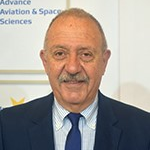Selected Papers from 7th International Conference of Engineering Against Failure (ICEAF VII)
A special issue of Metals (ISSN 2075-4701). This special issue belongs to the section "Metal Failure Analysis".
Deadline for manuscript submissions: closed (15 January 2024) | Viewed by 3450
Special Issue Editors
Interests: failure analysis; fracture analysis; fractography; fracture mechanics; mechanical behavior of materials; metallography; scanning electron microscopy; manufacturing technology; materials processing; machinability; surface engineering; corrosion; tribology; quality assurance; design of experiments
Special Issues, Collections and Topics in MDPI journals
Interests: sensors; magnetic materials; biotechnology; structure and properties of materials; steel health monitoring
Special Issues, Collections and Topics in MDPI journals
Interests: aeronautical materials and structures; mechanical behavior of materials; structural integrity; damage mechanics; experimental fracture mechanics; fatigue of aircraft materials and structures; ageing aircraft; characterization and manufacturing processes of polymers, thermosetting and thermoplastic composites; nanocomposites and nanocrystalline alloys; multifunctional and self-healing materials
Special Issues, Collections and Topics in MDPI journals
Special Issue Information
Dear Colleagues,
In recent decades it has been widely recognized that preventing the failure of engineering structures necessitates the involvement of a large amount of expertise and, depending on the application, a multidisciplinary and multi-scale approach may be required in terms of both size and time. The series of the International Conference of Engineering Against Failure (ICEAF) aims to provide on a biennial basis a forum to present relevant scientific and technological achievements and to discuss them with an audience of international experts.
The scope of the conference is to attract interdisciplinary work dedicated to the design against engineering failure, the implementation of appropriate guidelines against failure, the development and application of concepts and technologies to prevent failure, the use of both novel and established approaches, technologies, and tools for failure analysis, as well as a deep understanding of the underlying failure mechanisms and the identification of the root causes of failure.
The works are expected to cover a number of different technological areas including aeronautics and space, the automotive industry, the marine industry, wind energy, oil refineries and the chemical industry, civil engineering applications, bioengineering and medical applications, and so forth. The ICEAF VII conference is co-chaired by Spiros Pantelakis (Professor Emeritus, University of Patras, Laboratory of Technology and Strength of Materials) and Michael Vormwald (Professor, Head of Materials Mechanics Group, Technical University of Darmstadt) who will jointly share scientific responsibility for the conference.
The conference website: https://iceaf.eu/2023/home
The opening date for submissions is 26 June 2023.
Dr. George A. Pantazopoulos
Prof. Dr. Evangelos Hristoforou
Prof. Dr. Spiros Pantelakis
Guest Editors
Manuscript Submission Information
Manuscripts should be submitted online at www.mdpi.com by registering and logging in to this website. Once you are registered, click here to go to the submission form. Manuscripts can be submitted until the deadline. All submissions that pass pre-check are peer-reviewed. Accepted papers will be published continuously in the journal (as soon as accepted) and will be listed together on the special issue website. Research articles, review articles as well as short communications are invited. For planned papers, a title and short abstract (about 100 words) can be sent to the Editorial Office for announcement on this website.
Submitted manuscripts should not have been published previously, nor be under consideration for publication elsewhere (except conference proceedings papers). All manuscripts are thoroughly refereed through a single-blind peer-review process. A guide for authors and other relevant information for submission of manuscripts is available on the Instructions for Authors page. Metals is an international peer-reviewed open access monthly journal published by MDPI.
Please visit the Instructions for Authors page before submitting a manuscript. The Article Processing Charge (APC) for publication in this open access journal is 2600 CHF (Swiss Francs). Submitted papers should be well formatted and use good English. Authors may use MDPI's English editing service prior to publication or during author revisions.
Keywords
- engineering alloys and metals
- smart materials and structures
- multiscale approaches to understand the mechanical behavior and fracture of engineering materials and structures
- hybrid materials (metal–metal, metal composites, and hybrid composites)
- damage-tolerant microstructures
- damage tolerance of stiffened structures
- failure analysis of materials and components
- fracture and fatigue of materials and structures
- corrosion, wear, and surface degradation of materials and structures
- experimental studies on the relationship between microstructure and mechanical fracture processes
- computational mechanics and analytical methods
- modeling and simulated assessment of biomedical systems and materials
- characterization of fractures
- environmentally assisted fracture
- integrated approaches for the design, manufacturing, and reliability of engineering structures
- joining technologies
- non-destructive testing







